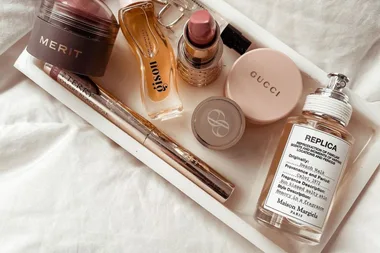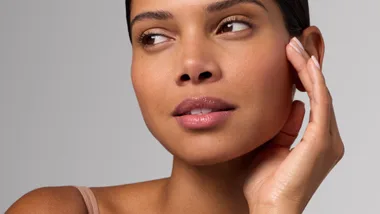As home and work life meld, we’re experiencing more screen time than ever – and research shows that our eyes are taking the brunt of the load. Sally Hunwick looks into the effects of fatigue on our eyes and how to manage it.
In a world where we’re increasingly seeing our homes as the HQ of not only our personal lives but also our work and social lives, the reliance on our devices to connect has increased to levels never see before. And there have been some knock-on effects to our complexions
With late-night scrolling of Instagram, deep dives into TikTok and our new obsession with Zoom, the stress of being in front of a screen for hours at a time is coming with a price tag. After seemingly countless weeks of lockdowns, many of us are experiencing a complexion that’s dehydrated, dull and lined. And much of it has to do with the spike in screen time that goes on well after we have clocked off from work.
By now, we’re across the concept of blue light affecting our complexions (it can break down collagen and make us age faster, much like sunlight can). But what the science is telling us now is that the skin around our eyes is taking the lion’s share of the damage, in the form of dehydration, puffiness, lines and wrinkles.
The reason our peepers are more damaged than the rest of our faces comes down to two things. Firstly, our skin in that area is 40 per cent thinner than on the rest of our face, leaving it more prone to collagen degradation and early ageing. Then there is the anatomical anomaly that many of our facial muscles are the only group of muscles directly attached to skin, putting added pressure on a fragile area. The combination of fragile skin and a heavy workload (thanks to all that screen time), means our eyes are forced into frequent micro movements, such as blinking and squinting (sound familiar?).
“The stress impact [of lockdowns] has been huge,” says Estée Lauder’s senior vice-president of R&D, Dr Nadine Pernodet. “We are spending many, many hours in front of the computer. This constant focus on the computer, the blue light, and the micro movements increases irritation in the delicate eye area.”

Research suggests this translates to collagen reserves depleting more quickly, and the skin around the eyes ageing more rapidly than it otherwise would.
That’s the bad news. The good news is that new technology cropping up in our skincare can help fortify this delicate (and tell-tale) area. Pernodet’s team has just released a new recruit to the cult-followed Advanced Night Repair range. It’s called Advanced Night Repair Eye Concentrate Matrix Synchronized Multi-Recovery Complex and it utilises a three-pronged approach to get our tired eyes looking, at the very least, as though we’ve had a good night’s sleep.
The formulation boasts a new, antioxidant-rich tech called Chronolux Power Signal Technology, which helps reduce the whole gamut of eye ageing (think crow’s feet, lines, wrinkles, lines, dark circles and laxity) and defends eyes against the environment. Then there’s the serum’s applicator, the Cooling Cryo-Steel wand, which cools the skin around the eyes by –2°C. Tired eyes feel more awake on contact with this clever tool.
But where this serum really gets exciting is with the new 360° Mesh Matrix technology. It is a “lightweight, flexible visco- elastic polymer matrix” with inbuilt hyaluronic acids and acts like a cushioning and fortifying support for the eye area.
To give you a visual, the matrix is like invisible scaffolding, where the eye area is being both supported and strengthened (studies suggest the area is up to 20 per cent stronger with the serum in place), all while the formulation gets to work on repairing damage, adding plumpness and visible smoothness while you sleep.
Estée Lauder is no stranger to night-working products. Its best selling Advanced Night Repair Serum has been coming to our collective rescue for decades now. “Research for Advanced Night Repair never stops,” says Pernodet. Her team is constantly working to advance the formula “based on the latest research and academia to try to move the bar in terms of performance, when we are already at the toppy-top of science. It takes years.”
The best-selling serum, recently updated with the Chronolux Power Signal Technology, is dosed with eight hours’ worth of antioxidants to help protect and repair just about every issue associated with environmental ageing, and hyaluronic acid for all-night hydration. Pair it with the new eye serum and you have some serious overtime invested in your skin while you hit the pillow.
On that note, you can work the ANR Eye Serum day and night. Plus, it also multitasks as a fixer for marionette lines and between the brows. Talk about round-the-clock support.
But don’t just burn the midnight oil and hope for the best – there are other steps you can take. “Trying to relax your eyes between meetings will help this really sensitive area,” advises Pernodet. Or, she says, step away from the computer altogether. “Close your eyes for a few minutes; this will really help to relax your eyes and pull back some of the added irritation created by the micro movements.”
Pay attention to your nightly wind down as well. Thirty minutes of tech-free time before bed, picking up a book rather than one last Insta scroll, or listening to a podcast all help lighten the load on our eyes. Because, let’s face it, we live in a world that can no longer move without tech, so adding resilience where we can, might just offset some of the device dependency.
This story originally appeared in the October issue of marie claire Australia, out now.











